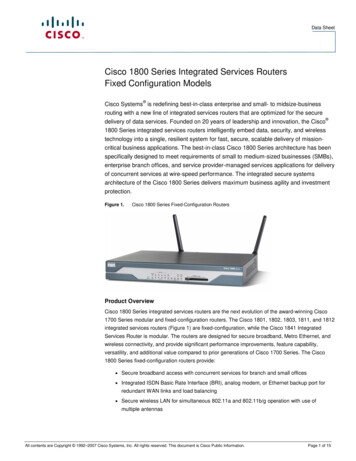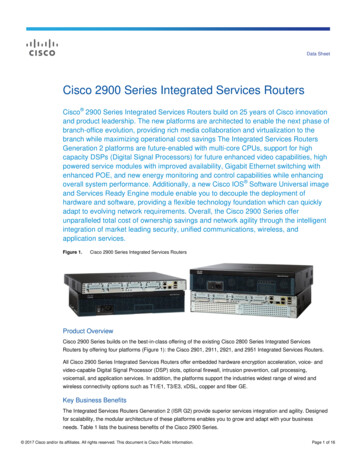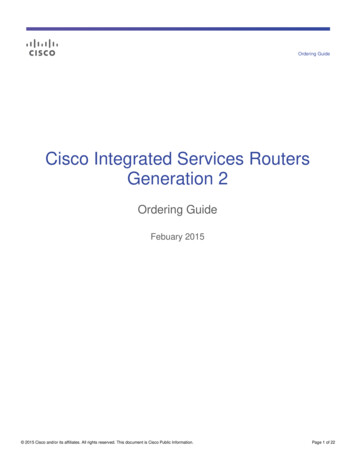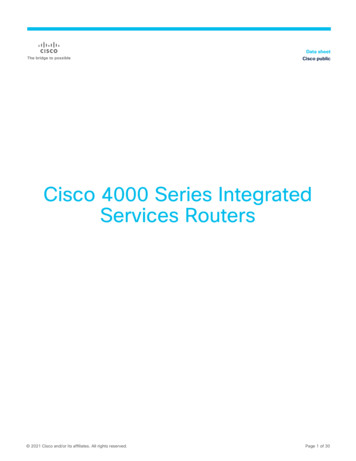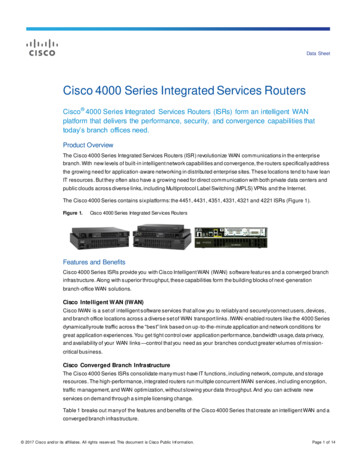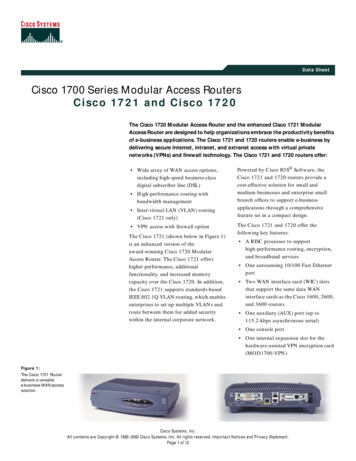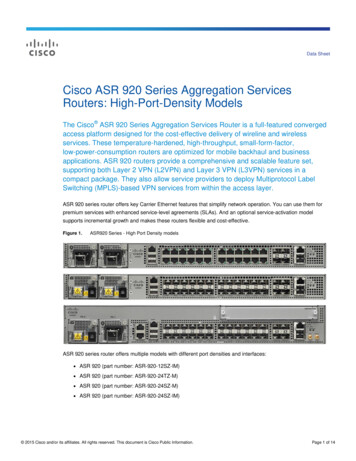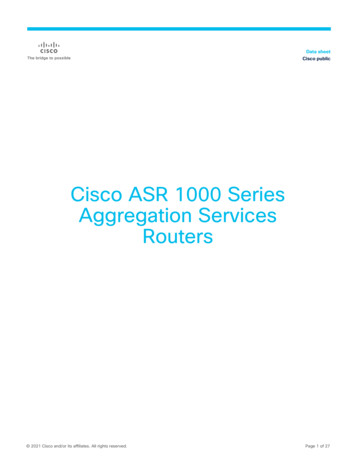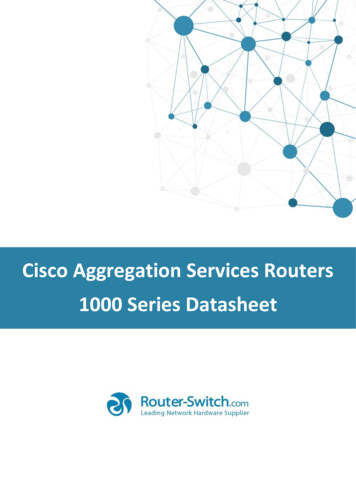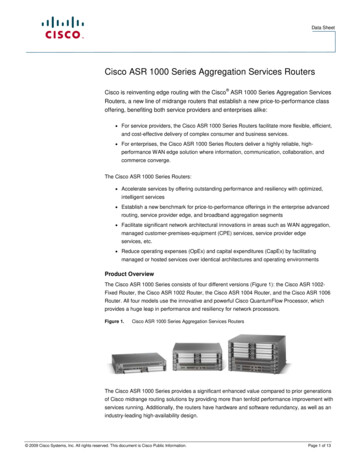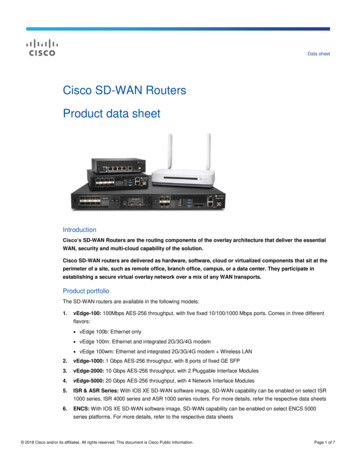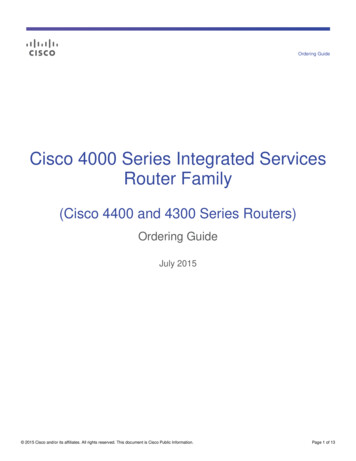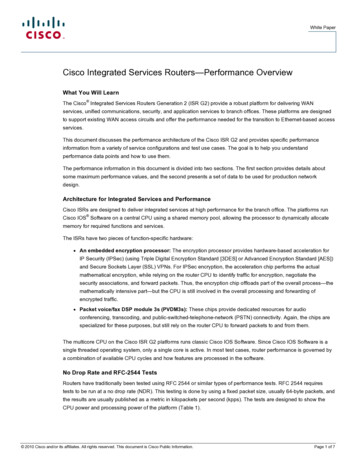
Transcription
White PaperCisco Integrated Services Routers—Performance OverviewWhat You Will Learn The Cisco Integrated Services Routers Generation 2 (ISR G2) provide a robust platform for delivering WANservices, unified communications, security, and application services to branch offices. These platforms are designedto support existing WAN access circuits and offer the performance needed for the transition to Ethernet-based accessservices.This document discusses the performance architecture of the Cisco ISR G2 and provides specific performanceinformation from a variety of service configurations and test use cases. The goal is to help you understandperformance data points and how to use them.The performance information in this document is divided into two sections. The first section provides details aboutsome maximum performance values, and the second presents a set of data to be used for production networkdesign.Architecture for Integrated Services and PerformanceCisco ISRs are designed to deliver integrated services at high performance for the branch office. The platforms run Cisco IOS Software on a central CPU using a shared memory pool, allowing the processor to dynamically allocatememory for required functions and services.The ISRs have two pieces of function-specific hardware:!An embedded encryption processor: The encryption processor provides hardware-based acceleration forIP Security (IPSec) (using Triple Digital Encryption Standard [3DES] or Advanced Encryption Standard [AES])and Secure Sockets Layer (SSL) VPNs. For IPSec encryption, the acceleration chip performs the actualmathematical encryption, while relying on the router CPU to identify traffic for encryption, negotiate thesecurity associations, and forward packets. Thus, the encryption chip offloads part of the overall process—themathematically intensive part—but the CPU is still involved in the overall processing and forwarding ofencrypted traffic.!Packet voice/fax DSP module 3s (PVDM3s): These chips provide dedicated resources for audioconferencing, transcoding, and public-switched-telephone-network (PSTN) connectivity. Again, the chips arespecialized for these purposes, but still rely on the router CPU to forward packets to and from them.The multicore CPU on the Cisco ISR G2 platforms runs classic Cisco IOS Software. Since Cisco IOS Software is asingle threaded operating system, only a single core is active. In most test cases, router performance is governed bya combination of available CPU cycles and how features are processed in the software.No Drop Rate and RFC-2544 TestsRouters have traditionally been tested using RFC 2544 or similar types of performance tests. RFC 2544 requirestests to be run at a no drop rate (NDR). This testing is done by using a fixed packet size, usually 64-byte packets, andthe results are usually published as a metric in kilopackets per second (kpps). The tests are designed to show theCPU power and processing power of the platform (Table 1). 2010 Cisco and/or its affiliates. All rights reserved. This document is Cisco Public Information.Page 1 of 7
White PaperAnother popular technique for providing router performance information is also an NDR test, but it is performed withmaximum packet size and presented as a throughput test. Results are delivered as megabits per second (Mbps).This test yields a maximum data-rate forwarding of specific features.Table 1.Cisco ISR G2 RFC 2544-Based Performance (kpps and Cisco3925ECisco3945Cisco3945Ekpps(64-byte s(1500-byte 80258675For NDR tests sometimes the platforms can process and forward packets faster than the aggregate bandwidth of theinterfaces that the specific models can support. In this situation, all available interfaces are driven to line rate andCPU usage recorded.What these tests do not provide is any indication of how the router will perform in a production environment. Theyassume that router CPUs scale linearly to the point where they drop packets. The tests provide no means foranalyzing router services, software-based algorithms, or other features. There is no ability to account for realprotocols, application layer gateways (ALGs), or other real-world traffic.Also, production networks tend to have varied packet sizes. Voice traffic and TCP acknowledgements (ACKs) tend tobe very small packets, generally 64 to 80 bytes. File transfers and some applications tend to use as large a packetsize as they can negotiate. Thus, NDR tests with fixed packet sizes do not provide a very realistic look at routerperformance in a production environment.Cisco IOS Software Security Services and PerformanceSecurity performance can be grouped into two categories—secure connectivity and threat defense. Secureconnectivity includes IPSec and SSL VPN technologies. From a performance perspective, threat defense focuses onfirewall technology.For IPSec, the focus is on throughput and scalability. IPSec throughput is measured using a single tunnel with 1400byte packets, with no Secure Hash Algorithm (SHA) or Message Digest Algorithm 5 (MD5) authentication. The packetsize must be reduced to account for the additional packet headers when using IPSec.With regard to secure connectivity, the United States government maintains very strict control on the export of strongcryptography, from both technology and performance standpoints. As with many other products, the Cisco ISRs aresubject to this regulation. In order to comply with this policy, both the temporary and permanent Security (SEC)licenses are limited in both performance and tunnel count. The limitation is applied to cumulative encrypted tunnelcounts and concurrent throughput. Encrypted tunnels are defined as IPSec, SSL VPN, or Secure Real-TimeTransport Protocol (SRTP). Currently that limitation is 170-Mbps throughput (85 Mbps in each direction) and 225tunnels. This limit is enforced and cannot be exceeded with the SEC license. The High-Performance Security (HSEC)license allows full scalability in both performance and connections.Table 2 gives performance information for IPSec and SSL VPN by platform. 2010 Cisco and/or its affiliates. All rights reserved. This document is Cisco Public Information.Page 2 of 7
White PaperTable 2.IPSec Maximum Performance by 925Cisco3925ECisco3945Cisco3945EIPSec Mbps (SEClicense only, noHSEC needed)46102125149170170170——————IPSec Mbps (SEC HSEC license)———————20728277014948481503A second data point for performance testing on secure connectivity technologies is maximum connections. Thismetric is not very applicable to the Cisco ISRs because they are primarily branch-office or access routers, deployedas customer premises equipment (CPE) in managed service environments, meaning that in most deployments therouters have to support only a few tunnels in a production environment. For IPSec, a tunnel is represented on therouter by configuration of a Virtual Tunnel Interface (VTI). Table 3 gives information about encrypted tunnel count byplatform.Table 3.Encrypted Tunnel Count by ed tunnels(SEC license)52050150150150225225225225225225225SSL VPN tunnels—1025507575100100150200500200500HSEC licenseIPSec VPN 0*The Cisco 860 models do not support SSL VPNFirewall testing is much more complicated than any other test discussed in this document. Zone-based firewall (ZBF)is a stateful application, maintaining and monitoring the state of all TCP connections through it. It has multiple ALGsthat allow it to inspect and monitor specific protocols and applications. ZBF also inspects traffic both within andbetween zones.Thus, test methodology significantly affects performance. Testing different applications invokes specific ALGs, eachof which may affect test results differently. Many test tools can generate packets with TCP headers, but nevercomplete the handshake and establish state for monitoring. In some situations, the firewall may see this situation as adenial-of-service (DoS) attack, because it would rarely be encountered in a production network unless under attack.The use of pure User Datagram Protocol (UDP) or other stateless traffic patterns can also produce varying results.For the purposes of this document, firewall is configured with two zones, and all traffic is sent between zones. Thetraffic generated is stateless and uses the same UDP port number. Performance is measured in maximum throughputand the number of maximum concurrent sessions. One element that influences the maximum-sessions metric is theamount of installed memory in the platforms. These tests used default memory. Table 4 gives firewall performanceinformation by platform. 2010 Cisco and/or its affiliates. All rights reserved. This document is Cisco Public Information.Page 3 of 7
White PaperTable 4.Firewall Performance by mumnumber ofconcurrentsessions (1000s)0.30.51.150636390130150270300305345Again, the data presented in this section is for maximum performance and is not very valuable for use in a productionnetwork. Although a router may be able to forward more than 1 Gbps of encrypted traffic in a lab-based performancetest, it should not be expected to perform at that level in a customer’s network. Packet sizes will vary in a realnetwork, and routers cannot be stressed to NDR.Maximum tunnels are a specific point where performance derived in a lab situation varies from a production design.Although this number is easy to reproduce in a test environment, very little traffic will be forwarded over those tunnelsduring the test.Firewall performance will vary depending on the nature of the traffic. Because ZBF monitors the state of traffic andmonitors specific protocols and applications, actual application traffic will affect the throughput of the firewall.Performance Positioning and RecommendationsPerformance positioning is an attempt to account for common deployment scenarios and make a recommendationthat will fit most requirements. The goal is to provide a recommendation that applies to 80 percent of customer usecases. It is not an all-inclusive metric, nor is it a performance limit of any kind. There will clearly be implementationswhere router performance can easily exceed the recommendations and others where specific configurations orservices, extremely small packet sizes, or other factors can reduce performance below these thresholds.Testing for the positioning performance ranges was conducted using Internet mix (IMIX) traffic. IMIX is a packet mixthat attempts to duplicate traffic bound for the Internet. Although it is not an industry standard, it is standardized withinthe test tool manufacturers. Every test tool manufacturer has its own version of IMIX, but the versions do not deviatesignificantly.Packet SizeTwo different IMIX traffic mixes were used for testing the Cisco ISR G2 routers. For test cases not involvingencryption, the following traffic mix was used:!1518 bytes x 15 packets (15%)!594 bytes x 24 packets (24%)!64 bytes x 61 packets (61%)The average packet size computes to 409 bytes.[(1518 x 15) (61 x 64) (24 x 594)/100 ] 409 2010 Cisco and/or its affiliates. All rights reserved. This document is Cisco Public Information.Page 4 of 7
White PaperFor test cases that used encryption, the maximum packet size needed to be reduced to avoid fragmentation. Thisreduction complies with best practices in VPN networks of setting the MTU to 1440 bytes on an interface to allow forIPSec headers.!1418 bytes x 15 packets (15%)!594 bytes x 24 packets (24%)!90 bytes x 61 packets (61%)The average packet size computes to 410 bytes.[(1418 x 15) (61 x 90) (24 x 594)/100 ] 410CPU UtilizationMost performance testing in a lab environment is performed between onboard Ethernet interfaces, although with theCisco 3900 Series Integrated Services Routers more Ethernet interfaces clearly had to be added to test platformcapacity. Ethernet interfaces provide the least processor overhead, because the router must simply swap MACheaders. Serial interfaces, including T1/E1, dial, and others, require a new Layer 2 encapsulation and thereforerequire more CPU involvement. Serial interfaces, by definition, also must serialize the packet flow. Thus, when usinga serial interface, the router passes less traffic at the same CPU usage than when using Ethernet interfaces.Another focus in creating a production-network focused set of performance data is on router CPU. As mentioned inthe previous section, NDR tests generally push the router CPU to 99–100 percent, because this level is the limitingfactor in raw performance. However, no production network is run at this type of CPU usage. Traffic on real-worldnetworks is bursty, not smooth and consistent like a lab test. Lab routers do not have to converge routing protocolsbecause of real-world events. A router running at 99-percent CPU usage could never handle any of these events.Most service providers set their CPU alarms to 60 or 65 percent. Many enterprise customers are comfortable runningproduction networks with CPU around 70 or 75 percent. For performance positioning of the Cisco ISR G2 routers, theCPU threshold is set to 75-percent usage. This setting provides a valid metric for how the router will perform in aproduction environment, allowing for large traffic bursts and routing protocol convergence.Single Cisco IOS Software ServicesA recent analysis indicated that Cisco IOS S
Cisco ISRs are designed to deliver integrated services at high performance for the branch office. The platforms run Cisco IOS Software on a central CPU using a shared memory pool, allowing the processor to dynamically allocate memory for required functions and services. The ISRs have two pieces of function-specific hardware: !
